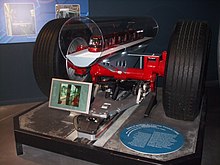This article has multiple issues. Please help improve it or discuss these issues on the talk page. (Learn how and when to remove these messages)
|

A rubber-tyred tram (also known as tramway on tyres, French: tramway sur pneumatiques) is a development of the guided bus in which a vehicle is guided by a fixed rail in the road surface and draws current from overhead electric wires (either via pantograph or trolley poles).
Two incompatible systems using physical guide rails exist: the Guided Light Transit (GLT) designed by Bombardier Transportation, and the Translohr from Lohr Industrie (currently made by Alstom and FSI). There are no guide bars at the sides but there is a central guidance rail that differs in design between the systems. In the case of Translohr, this rail is grasped by a pair of metal guide wheels set at 45° to the road and at 90° to each other. In the GLT system, a single double-flanged wheel between the rubber tires follows the guidance rail. In both cases, the weight of the vehicle is borne by rubber tires to which the guide wheels are attached, which make contact with the road on concrete roll ways designed to minimise impact on the ground. Power is usually supplied by overhead lines, rechargeable batteries, or internal combustion engines where there are no overhead wires.
Characteristics

The Translohr system operates as a guided vehicle at all times, while with the Bombardier system the vehicles can be driven independently as requirements dictate, such as journeys to the depot. Consequently, the Bombardier vehicles are legally considered buses, and must bear rear-view mirrors, lights and number plates, and are controlled with steering wheels and pedals like ordinary buses, though the steering wheel is not used when following the guidance rail. On the other hand, Translohr vehicles operate like standard trams and cannot move without guidance, so they are not classified as buses and are not equipped with number plates. The ART system can be diverted by virtual track by the driver using a conventional steering wheel.
These systems have been likened to the tram equivalent of rubber-tyred metros, and they are also less efficient than steel-wheeled light rail vehicles. There is no evidence to prove the superiority of either guidance system. Both Bombardier and Translohr have had derailments during operation.
Systems in operation
 Diagram of the Translohr guide rail (green) and the tram's guide wheels (red)
Diagram of the Translohr guide rail (green) and the tram's guide wheels (red) Diagram of the guide rail and guide wheel of the Bombardier's GLT
Diagram of the guide rail and guide wheel of the Bombardier's GLT
Translohr
Main article: Translohr- Clermont-Ferrand tramway, France (STE4, since 2006)
- Padua tramway, Italy (STE3, since 2007)
- Mestre-Venice tramway, Italy (STE3, since 2010)
- Île-de-France tramway Line 5, France (STE3, since 2013)
- Île-de-France tramway Line 6, France (STE6, since 2014)
- Ayacucho Tram, Medellin, Colombia (STE5, since 2015)
- Translohr switches and crossing
-
 Translohr flexible single rail switch
Translohr flexible single rail switch
-
 Translohr rigid two-rail switch
Translohr rigid two-rail switch
-
 Translohr rail crossing
Translohr rail crossing
Retired systems
Bombardier Guided Light Transit (GLT)
Main article: Bombardier Guided Light Transit- Nancy Guided Light Transit, France (2001–2023) – 40% of the line ran as a driver-steered trolleybus, and was part of the Nancy trolleybus system. The entire route was to be replaced by a tramway, but those plans were dropped in 2021, and it is being converted back into a conventional trolleybus system because of the higher cost of a tramway.
- Caen Guided Light Transit, France (2002–2017) – GLT closed in 2017 and converted to light rail which opened in 2019.
Translohr
Main article: Translohr- Zhangjiang Tram, Shanghai, China (STE3, 2010–2023); closed due to high operating costs and low ridership.
- TEDA Modern Guided Rail Tram, Tianjin, China (STE3, 2007–2023); closed due to maintenance issues.
Proposed systems
- Cambridge, United Kingdom. One of the three systems under consideration for the proposed 90 mi (140 km) Cambridge Autonomous Metro utilises a "fully autonomous, battery-powered road transport vehicle". (The other options are a personal rapid transit and a guided bus. An upgrade bus service is also being considered.)
See also
- Larmanjat guided rail system
- Autonomous Rail Rapid Transit
- Budd–Michelin rubber-tired rail cars
- Flat tire
- Outline of tires
- Trackless tram
References
- "Further Problems in Nancy". LRTA. 20 November 2002. Retrieved 18 July 2016.
- "国内首条现代导轨电车出轨" [The First Modern Guided Tramway in China Derails]. News.QQ.com (in Chinese). 20 August 2007.
- "Worldwide Review " (November 2017). Tramways & Urban Transit, p. 431. UK: LRTA Publishing. ISSN 1460-8324.
- "Alstom trams to replace Caen TVR" (January 2017). Tramways & Urban Transit, p. 7. UK: LRTA Publishing. ISSN 1460-8324.
- "Tramway à Caen. Le Jour où il s'est Arrêté" [Tramway in Caen: The Day It Closed]. Ouest-France (in French). 4 January 2018. Retrieved 23 May 2023.
- Dardenne, Elodie (3 December 2018). "Tramway à Caen. Pour l'Instant, ça Roule" [Tramway in Caen: For the Moment, It Rolls]. Ouest-France (in French). Retrieved 23 May 2023.
- "TDI Unveils Cambridge Autonomous Metro Concept". 12 April 2021. Retrieved 24 July 2021.